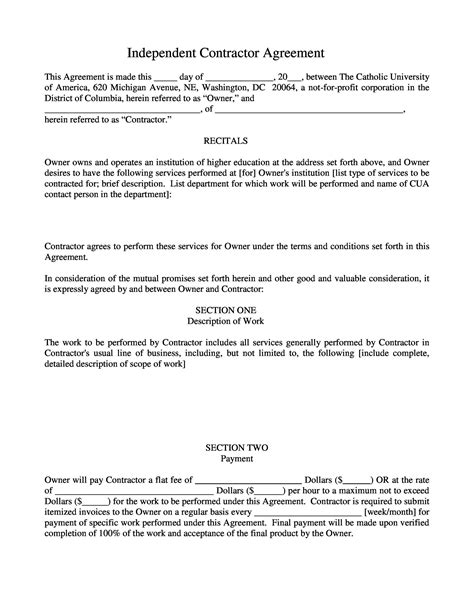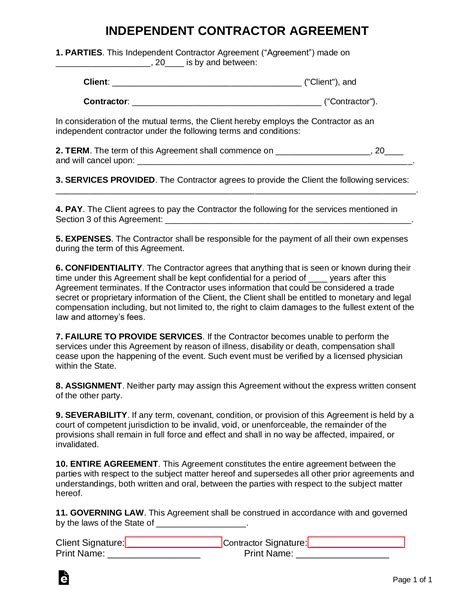Contractor To Contractor Agreement

A Contractor to Contractor Agreement, also known as a Subcontractor Agreement, is a legally binding contract between two or more independent contractors who agree to work together on a specific project. This agreement outlines the terms and conditions of their collaboration, including the scope of work, payment terms, and responsibilities of each party. In this article, we will delve into the intricacies of Contractor to Contractor Agreements, exploring their key components, benefits, and potential pitfalls.
Key Points
- A Contractor to Contractor Agreement is a legally binding contract between two or more independent contractors.
- The agreement outlines the scope of work, payment terms, and responsibilities of each party.
- It helps to establish clear expectations, minimize disputes, and ensure a smooth working relationship.
- The agreement should include provisions for confidentiality, intellectual property, and termination.
- It's essential to have a well-drafted agreement to protect the interests of all parties involved.
Understanding the Contractor to Contractor Agreement

A Contractor to Contractor Agreement is a critical document that helps to establish a clear understanding between independent contractors working together on a project. This agreement typically includes provisions for the scope of work, payment terms, deadlines, and responsibilities of each party. By having a well-drafted agreement in place, contractors can minimize the risk of disputes, ensure a smooth working relationship, and protect their interests.
Key Components of a Contractor to Contractor Agreement
A comprehensive Contractor to Contractor Agreement should include the following key components:
- Scope of Work: A detailed description of the services to be provided by each contractor, including the specific tasks, deliverables, and timelines.
- Payment Terms: The agreement should outline the payment terms, including the amount, method, and frequency of payments.
- Responsibilities: A clear definition of the responsibilities of each contractor, including their obligations, duties, and liabilities.
- Confidentiality: A provision to protect confidential information and trade secrets shared between the contractors.
- Intellectual Property: A clause to establish ownership and rights to intellectual property created during the project.
- Termination: A provision outlining the circumstances under which the agreement can be terminated, including notice periods and termination fees.
| Component | Description |
|---|---|
| Scope of Work | A detailed description of the services to be provided by each contractor. |
| Payment Terms | The agreement should outline the payment terms, including the amount, method, and frequency of payments. |
| Responsibilities | A clear definition of the responsibilities of each contractor, including their obligations, duties, and liabilities. |

Benefits of a Contractor to Contractor Agreement

A Contractor to Contractor Agreement offers numerous benefits, including:
- Clear Expectations: The agreement helps to establish clear expectations and understanding between the contractors, minimizing the risk of misunderstandings and disputes.
- Protection of Interests: The agreement protects the interests of all parties involved, including their intellectual property, confidential information, and trade secrets.
- Smooth Working Relationship: A well-drafted agreement helps to ensure a smooth working relationship between the contractors, promoting collaboration and cooperation.
- Reduced Risk of Disputes: The agreement reduces the risk of disputes by providing a clear framework for resolving conflicts and addressing issues that may arise during the project.
Potential Pitfalls of a Contractor to Contractor Agreement
While a Contractor to Contractor Agreement offers numerous benefits, there are also potential pitfalls to be aware of, including:
- Ambiguous Terms: Ambiguous terms and conditions can lead to misunderstandings and disputes between the contractors.
- Unrealistic Expectations: Unrealistic expectations and deadlines can lead to frustration and disappointment among the contractors.
- Lack of Flexibility: A rigid agreement can make it difficult to adapt to changing circumstances and project requirements.
- Inadequate Dispute Resolution: Inadequate dispute resolution mechanisms can lead to prolonged and costly disputes between the contractors.
What is the purpose of a Contractor to Contractor Agreement?
+The purpose of a Contractor to Contractor Agreement is to establish a clear understanding between independent contractors working together on a project, outlining the scope of work, payment terms, and responsibilities of each party.
What are the key components of a Contractor to Contractor Agreement?
+The key components of a Contractor to Contractor Agreement include the scope of work, payment terms, responsibilities, confidentiality, intellectual property, and termination provisions.
What are the benefits of a Contractor to Contractor Agreement?
+The benefits of a Contractor to Contractor Agreement include clear expectations, protection of interests, a smooth working relationship, and reduced risk of disputes.
In conclusion, a Contractor to Contractor Agreement is a vital document that helps to establish a clear understanding between independent contractors working together on a project. By including key components such as scope of work, payment terms, and responsibilities, the agreement can help to minimize disputes, ensure a smooth working relationship, and protect the interests of all parties involved. It’s essential to have a well-drafted agreement in place to avoid potential pitfalls and ensure a successful collaboration.



